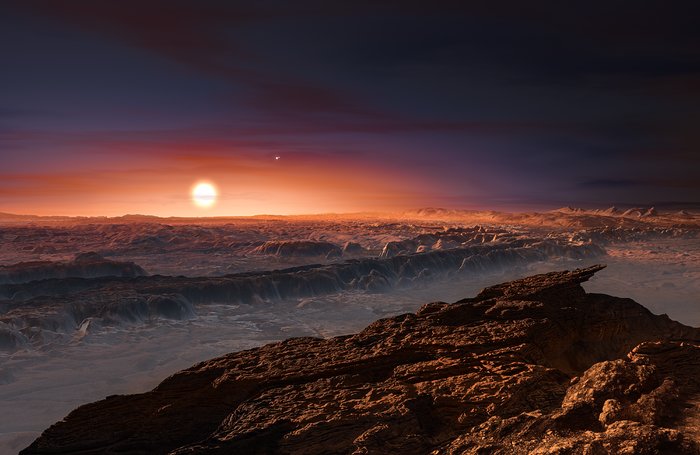Huzzah. A vaguely Earth-ish planet has been confirmed to have been detected orbiting the red dwarf Proxima Centauri, 4.25 lightyears away. It hasn’t been visually observed; detection was by way of detecting the slight wobble of Proxima (via Doppler shift) caused by the gravitational pull of the much smaller planet.
What’s known about Proxima Centauri B:
Mass is 1.3 Earths or more; 90% chance that it’s less than 3 Earth masses.
The length of the local “year” is 11.186 terrestrial days.
It’s 4.3 million miles from Proxima (about 0.046 AU)
It’s in the “habitable zone” where liquid water can exist. It gets about 65% the solar flux as Earth does.
Proxima Centauri is an unfriendly host star, with X-Ray bursts and the like that, even though the planet might be in the habitable zone, would potentially blow any atmosphere off the planet. It gets about 400 times the X-ray flux as Earth.
Not much more than that at this time. Speculations and ramblings:
If the planet is low in heavy metals, being basically just a chunk of rock, the greater mass than Earth might still result in an Earth-like surface gravity (and a noticeably larger planetary diameter).
Chances are good that it’s tidally locked to Proxima. But it might be in a resonance, such as three rotations for every two revolutions. If so, it would have some long days, but that would help it maintain proper weather patterns, rather than a perpetually frozen dark side and a day side with the atmosphere cooked off.
It *might* have a substantial moon (it’s possible that the 1.3 Earth masses might be distributed as, say, a 1 Earth mass planet and a 0.3 Earth mass moon). To pull this off, the two would have to be close. Chances would then be good that the planet might be tidally locked with the *moon.* In any case, if it has a close, massive moon, tidal forces between the moon and the star would make the planet tectonically entertaining.
If it’s a big fluffy rock… probably no magnetosphere to speak of. And thus probably no atmosphere to speak of, unless it’s a high molecular weight hellscape of burning carbon dioxide like Venus. If it has a spinning molten iron core, then maybe a good magnetosphere and some useful protection from Proximas tantrums.
Red dwarfs like Proxima have lifespans measured in *trillions* of years. So assuming phantom energy doesn’t tear the universe apart in a few billion years, Proxima will be sullenly glowing away when it is 300 times the current age of the universe. The sun will be a cold, dark black dwarf and the remaining planets flung off into the galaxy long before Proxima will have expired in about 4,000,000,000,000 years. Of course by that point Sol and Proxima will be nowhere near each other; tens or hundreds of thousands of galactic revolutions will see to it that the two systems wander far apart from each other. By the time Proxima nears its end, the galaxy will be a shadow of itself… somewhat lower in mass due to having flung stars out into the universe (unless it’s heavier due to colliding with Andromeda and the two melding together) and from mass-energy having been radiated away for trillions of years; very, very red and dark, with the only stars still burning being red dwarfs like Proxima, some younger than Proxima with still more trillions of years of life in ’em. If Proxima B still orbits Proxima, the night sky would be almost utterly black. There would be almost no other galaxies visible; they will have all wandered off over the visible horizon by that point. The only stars in the sky would be other red dwarfs… and from Earth, Proxima Centauri is invisible to the naked eye. So even though there might still be millions of red dwarfs still cooking along… you’d need a pretty good telescope to see even the closest ones.
Since Proxima is relatively cool, much more of its radiant energy is shifted towards the infra-red end of the spectrum. Someone standing on Proxima B would still see things in pretty much normal color, but the sky would look funny. With less light on the blue end of the spectrum, there’d be that much less blue light to scatter in the atmosphere, thus it’d look dark in daytime. Not sure if you’d be able to see stars in daytime, but maybe…
